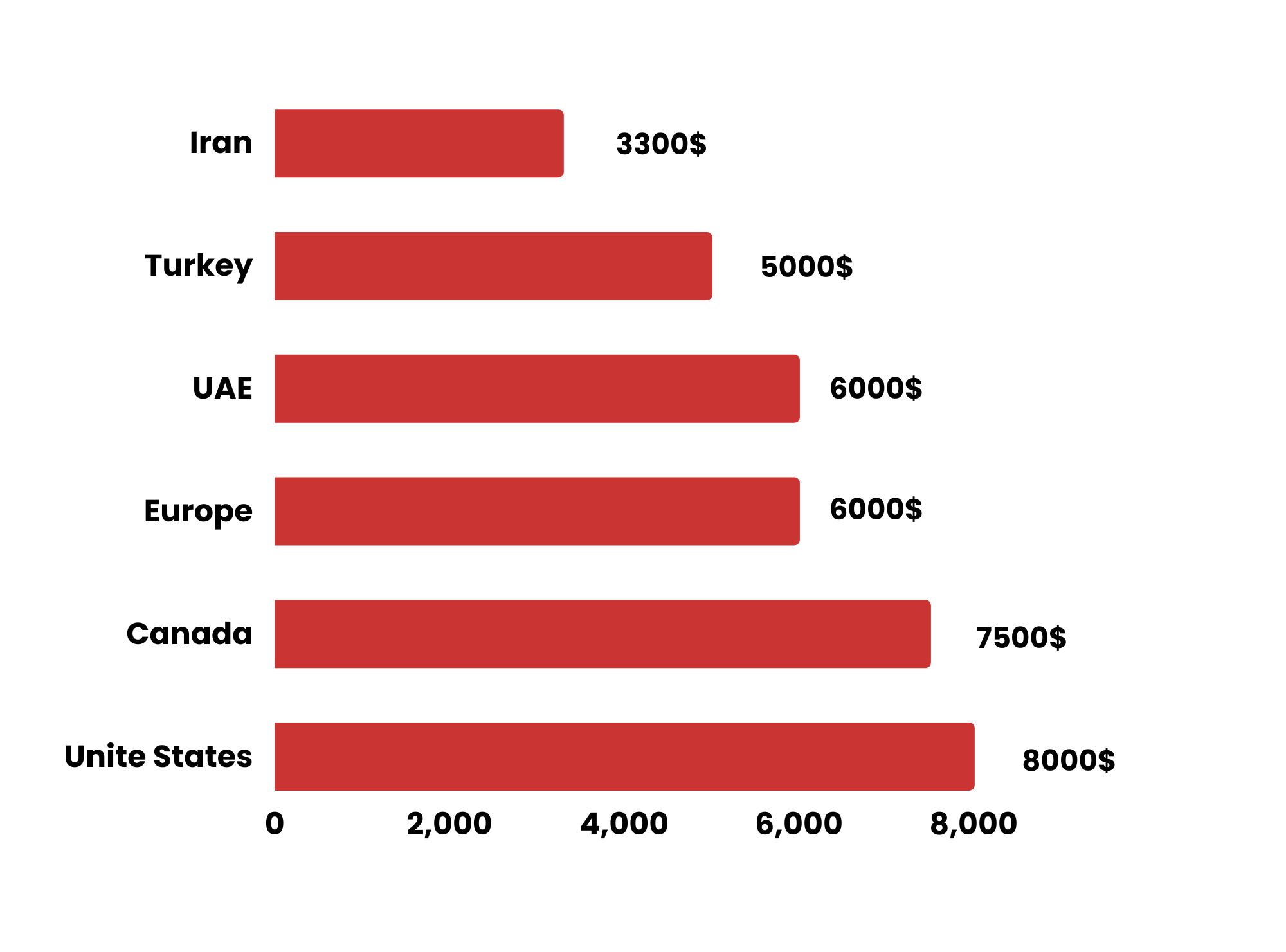Myomectomy in Iran
If uterine fibroids are causing pelvic pain, irregular periods, and heavy menstrual bleeding, we suggest a myomectomy in Iran. We offer several myomectomy packages so that you won’t worry about myomectomy surgery costs in Iran during your trip.

Myomectomy in Summary
Recovery Time
2-3 Weeks
Hospital Day
Surgery Duration
2-4 hours
Anesthesia
General
Back to Work
1-2 Weeks
Stay in Iran
Why Choose Iran for Myomectomy?
When it comes to myomectomy, Iran has many advantages:
- Professional Surgeons
- Modern and Well-equipped Hospitals
- Cost-effective Myomectomy Packages
When you choose to undergo myomectomy surgery in Iran, you will benefit from our full-service myomectomy packages. We cover all your needs during your trip to Iran and ensure you safe and high-quality surgery while having a seamless travel experience.
PackagesMyomectomy in LyaMed
Economic
Myomectomy- 5 Nights at 3*Hotel
- Welcome Dinner
- Half-day Sightseeing
- Medical Imaging & Tests
- Visa
- Transportation
- 24/7 Interpreter
- Follow Up
- SIM Card & Internet
Special
Myomectomy- 5 Nights at 4*Hotel
- Welcome Dinner
- Half-day Sightseeing
- Medical Imaging & Tests
- Visa
- Transportation
- 24/7 Interpreter
- Follow Up
- SIM Card & Internet
VIP
Myomectomy- 5 Nights at 5*Hotel
- Welcome Dinner
- Half-day Sightseeing
- Medical Imaging & Tests
- Visa
- Transportation
- 24/7 Interpreter
- Follow Up
- SIM Card & Internet
PricingMyomectomy Cost in Iran
The myomectomy cost in Iran is significantly more affordable than in many other countries, particularly in Europe, Turkey, and the USA.
If you’re seeking an attractive destination for fibroidectomy in Iran, we can provide cost-effective packages.
This cost advantage of fibroidectomy in Iran is attributed mainly to the high demand for medical services.
The expenses for myomectomy surgery in Iran may vary depending on the type of procedure and the hospital. On average, a myomectomy surgery cost in Iran is around $3,300, while the same procedure may cost $8,000 in the United States, $6,000 in Europe, $5,000 in Turkey, and $6,000 in the UAE.

What is Myomectomy?
Myomectomy is a procedure performed to remove uterine fibroids from the uterus. These fibroids can cause symptoms in women who are of childbearing age.
In contrast with hysterectomy, which involves removing the uterus, myomectomy specifically targets the fibroids while preserving the uterus.
During a myomectomy, the surgeon removes fibroids while ensuring that the uterus continues to function. Women can relief from symptoms such as bleeding and pelvic pressure while still potentially becoming pregnant in the future.
What are the Different Types of Myomectomy?
Myomectomy procedure is classified into 3 types, all of which LyaMed offers in our packages.
Abdominal Myomectomy (Laparotomy)
In abdominal myomectomy or Open Myomectomy, your surgeon makes an incision on the lower abdomen, known as a bikini line, to access your uterus and remove fibroids.
After the incision, the surgeon removes fibroids from the uterine wall and stitches the uterine muscle layers together.
It is important to note that fibroids can reappear, leading to additional procedures and recurrent symptoms. This surgical procedure is ideal for treating large fibroids as it provides the surgeon with a clear view of all pelvic organs.
If you become pregnant in the future, your doctor may recommend a C-section to reduce labor and the risk of uterine rupture caused by your previous myomectomy.
There are a few ways to carry out this procedure.
Horizontal Incision
A horizontal incision is made over the pubic bone, typically 3-4 inches long. While this incision causes less pain and leaves a smaller scar, it may not be sufficient for removing large fibroids.
Vertical Incision
A vertical incision from below the belly button to above the pubic bone is rarely used nowadays but may be preferred for larger fibroids to reduce bleeding.
Laparoscopic Myomectomy (Robotic Myomectomy)
In laparoscopic or robotic myomectomy, fibroids are removed through small abdominal incisions. This procedure can only remove specific types of fibroids.
The procedure starts with making small incisions in the lower abdomen, including the belly button, bikini line, and near each hip. Carbon dioxide gas is then used to fill the abdominal cavity. A laparoscope, which is a thin telescope, is inserted through one of the incisions to allow doctors to view the ovaries, fallopian tubes, and uterus. Long instruments are inserted through the other incisions to remove the fibroids. In the end, the uterine muscle is stitched together, the gas is released, and the surgeon closes skin incisions.
Additionally, there are instances where a laparoscopic myomectomy must be switched to an abdominal myomectomy during the operation. Depending on the fibroids’ size, quantity, and location, an abdominal myomectomy may be required.
Laparoscopy may cause less blood loss, shorter hospital stays and recovery time, and lower complications and adhesion formation rates.
When it comes to comparing laparoscopic and robotic myomectomy, there are small differences:
Laparoscopic Myomectomy
During laparoscopic myomectomy, the surgeon makes a small incision in the belly button and inserts a laparoscope into the abdomen. The surgery is then performed with instruments inserted through small incisions in the abdominal wall.
Robotic Myomectomy
Robotic myomectomy is similar to laparoscopic myomectomy, but the surgeon uses a console to control the movement of the instruments inserted through small incisions. This method removes numerous complexes or adhesions in the uterine wall.
Single port myomectomy
This surgery utilizes a single incision near the belly button for all instruments, resulting in only one incision in the abdomen.
Hysteroscopic Myomectomy
To treat submucosal fibroids, your surgeon may suggest a hysteroscopic myomectomy. In this surgery, the fibroids are removed through instruments inserted into your uterus via your cervix and vagina.
During this surgery, a surgeon will insert a small, illuminated device through your vagina and cervix into your uterus. They typically use either a wire loop resectoscope or a hysteroscopic morcellator to remove tissue. This is often used to remove fibroids specifically. The surgeon uses a resectoscope to remove small portions of the fibroid until it is completely extracted from the uterus. In some cases, the surgery may need to be performed in 2 stages when dealing with bigger fibroids.
What Does Myomectomy Treat?
Myomectomy can cure pelvic pain, heavy periods, irregular bleeding, and frequent urination.
Myomectomy and Pregnancy
Myomectomy is a surgical procedure with the main benefit of preserving fertility, which means that those who undergo it can still become pregnant after fibroid removal.
Furthermore, if fibroids acted as a barrier to pregnancy, the procedure might even enhance fertility. However, abdominal and laparoscopic myomectomies require an incision affecting the myometrium. This may put the patient at higher risk of uterine rupture during pregnancy and labor.
As a result, pregnant individuals who have undergone uterine fibroid removal often require a cesarean delivery.
Who is a Good Candidate for Myomectomy?
A good candidate for myomectomy is typically a woman dealing with fibroids who desire future pregnancy or wishes to preserve her uterus for other reasons.
Myomectomy, unlike hysterectomy, selectively removes fibroids while retaining the uterus. The suitability of the myomectomy approach, depends on factors such as the size and location of the fibroids.
This procedure is beneficial for women facing fibroid-related infertility or those seeking relief from fibroid symptoms.
How is Myomectomy surgery in Iran performed: Step-by-Step Guide
If you decide to undergo myomectomy in Tehran, we provide everything you need during this process. By choosing LyaMed as your assistant during this trip we provide our services in the following steps:
- Online Consultation
- Visa Assistance
- Transportation
- Accommodation
- Hospital
- Treatment
- Recovery Time
- Sightseeing
- Online Follow-Up Visits
How to Prepare for Myomectomy
Your physician may prescribe medications aimed at reducing the size of your fibroids for easier removal. Once you discontinue these drugs, your menstrual cycle will resume, enabling the possibility of pregnancy.
it’s essential to address any questions regarding the preparation process and surgery expectations with your doctor.
Depending on your risk factors, you may need various health assessments, including blood tests, electrocardiograms, MRI scans, and pelvic ultrasounds.
If you smoke, it is crucial to quit a few weeks before the surgery.
Additionally, you should refrain from eating or drinking after midnight on the night before your surgery.
Recovery Process from Myomectomy
Following a myomectomy, discomfort and postoperative pain are common. Your doctor may prescribe medication to alleviate your discomfort. Additionally, you may experience spotting for several days to a few weeks.
The duration of your recovery period depends on the type of myomectomy procedure you undergo.
Recovery timelines for each procedure are as follows: abdominal myomectomy typically takes 4 to 6 weeks, laparoscopic myomectomy ranges from 2 to 4 weeks, and hysteroscopic myomectomy generally necessitates only 2 to 3 days.
It’s essential to avoid heavy lifting and strenuous exercise until your incisions have completely healed. Ask your doctor to guide you when you can resume these activities. You should also consult your doctor regarding the appropriate time to resume sexual activity, which may involve a wait of up to 6 weeks.
Potentially, your body requires a 3 to 6 month wait for full uterine healing, depending on the surgical approach.
Risks and Complications of Myomectomy
Like any surgical procedure, myomectomy carries potential risks, although they are infrequent. These risks include infection, excessive bleeding, harm to neighboring organs, uterine perforation, and scar tissue formation. This tissue may obstruct fallopian tubes or result in fertility issues and the emergence of new fibroids, necessitating further removal.
Contact your surgeon if you experience heavy bleeding, fever, severe pain, or difficulty breathing following your fibroidectomy.
Why You Should Choose LyaMed for Myomectomy in Iran?
If you’re contemplating a fibroidectomy in Iran, look no further than LyaMed as your trusted partner for achieving outstanding results.
We offer competitive uterine myomectomy cost while upholding the highest standards of quality and patient care.
Our team, dedicated to addressing your specific needs and ensuring a successful procedure.
LyaMed is here to support you every step of the way whether you choose fibroidectomy or hysterectomy in Iran. Schedule your consultation today and start your journey to improved health and well-being with us.
Frequently Asked Questions About Myomectomy in Iran
How much does liposuction cost in Iran?
360 degree liposuction cost in Iran is about 2400$.
What is 360-degree liposuction?
The lipo 360 procedure is a surgical method that removes unwanted fat from multiple body areas at once. Unlike traditional liposuction, which only targets a single body area for fat removal, lipo360 tackles multiple areas simultaneously.
Which countries are the best for liposuction?
- Iran
- Brazil
- South Korea
- Malaysia
- Thailand
Does the fat come back after 360 degree liposuction?
lipo 360 is a permanent surgery and the results will last for a long time if you maintain a healthy diet and lifestyle.
Does lipo 360 leave a scar?
There might be some tiny scars because of the holes the surgeon made during liposuction.
How long does the 360 degree liposuction take?
2-4 hours
What is the recovery time for 360-degree liposuction?
The recovery period varies from person to person, but generally, patients can expect to resume their normal activities within 1 to 2 weeks after the procedure.
How can I find a reputable plastic surgeon for 360-degree liposuction in Iran?
We offer the best liposuction 360 surgeons in our liposuction packages and cover all you need for 360-degree liposuction in Iran.

0 Comments